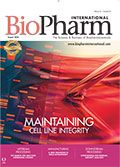Submitting Extractables and Leachables Data to Regulators
The type of product, the packaging materials being used, and the process and materials used to manufacture the product will determine when E&L data should be submitted to regulators, says Susan J. Schniepp, executive vice-president, Post-approval Pharmaceuticals and distinguished fellow at Regulatory Compliance Associates.
Q: I am a regulatory professional working for a small company with a product in the early stages of development. Can you tell me when I need to submit the extractable/leachable information for my product?
A: There is a lot of information on what extractables and leachables are but there is little information on when this information should be submitted to the regulatory authorities. The best place to start in answering your question is to define what extractables and leachables (E&L) are and why they are considered important.
Extractables are defined as chemical compounds that can be pulled from the primary container/closure components into the drug product. Basically, they are generated by the product and the packaging interacting over time, usually in the presence of a solvent under extreme condition of time and temperature.
Leachables are slightly different and are defined as compounds that leach or migrate into the product from the interaction between the product and the container/closure system.
The regulatory requirements that justify performing E&L studies are defined by 21 Code of Federal Regulations (CFR) 211.94(a), which states “Drug product containers and closures shall not be reactive, additive, or absorptive so as to alter the safety, identity, strength, quality, or purity of the drug beyond the official or established requirements” (1). Regulation 21 CFR 600.11(h) states, “All final containers and closures shall be made of material that will not hasten the deterioration of the product or otherwise render it less suitable for the intended use. All final containers and closures shall be clean and free of surface solids, leachable contaminants, and other materials that will hasten the deterioration of the product or otherwise render it less suitable for the intended use” (2).
While the regulations in the United States seem to deal with extractable/leachables from the container/closure system, when deciding what to submit in your registration you should also consider your manufacturing equipment as potential sources of extractables and leachables.
This can include, but is not limited to, filters, tubing, and/or equipment materials of construction as indicated in the European regulations.
In Europe, EudraLex Volume 4, Part 1, Chapter 3 addresses the extractable/leachable concept by stating, “Production equipment should not present any hazard to the products. The parts of the production equipment that come into contact with the product must not be reactive, additive, or absorptive to such an extent that it will affect the quality of the product and thus present a hazard” (3). Traditionally, E&L data were gathered and submitted in the late stages of the drug development process. Packaging suppliers were often able to provide an extractable/leachable package for their materials to the pharmaceutical manufacturer in a format that could be submitted directly to the agencies. Lately, regulatory authorities are requesting this type of information for early stage clinical trial material. This change seems to have come about during the past few years. The extractables and leachables profile in clinical trial material has become a growing concern for regulatory authorities, mostly due to advances including unique packaging materials, new and novel formulations, new drug delivery systems, new combination products being introduced, the emergence of biologics and biosimilars, and the increasing use of single-use disposables systems for manufacturing.
Why we need to submit this information is clear, but when to submit the E&L data depends on the product type, the container and closure system being used, as well as the materials and equipment used in manufacturing. If you are developing a generic with the same active and packaging components as the brand drug, the E&L report can be submitted and be available later in the process.
If this is a new novel product associated with clinical trials or an old active being reformulated into a new dosage form (e.g., from a tablet to an injection) then you should probably have the E&L report much earlier in the process.
If you are updating the manufacturing process of an old product to use single-use disposable systems, you should include the E&L information as early in the filing update as possible. If you are developing a new, novel product using unique packaging components and new manufacturing advancements, this information should be evaluated early in the development of the product and be available to regulators as soon as is feasible.
Bottom line, there is no clear rule or guidance on when you need to submit E&L data. It depends on the type of product, the packaging materials being used, and the process and materials used to manufacture the product. Performing a risk evaluation on your product by asking the above questions can help your company determine when to have the extractable/leachable information available so the approval process is not delayed, and your product can be available for patients as soon as possible.
References
1. 21 Code of Federal Regulations (CFR) 211.94(a).
2. 21 CFR 600.11(h).
3. European Commission, EudraLex, The Rules Governing Medicinal Products in the European Union EU Guidelines to Good Manufacturing Practice Medicinal Products for Human and Veterinary Use, Volume 4, Good Manufacturing Practice Guidelines, Part 1, Chapter 3 (European Commission, March 1, 2015).
Article Details
BioPharm International
Vol. 31, No. 8
August 2018
Pages: 38, 37
Citation
When referring to this article, please cite it as S. Schniepp, "Submitting Extractables and Leachables Data to Regulators," BioPharm International 31 (8) 2018.
